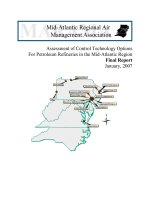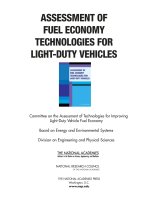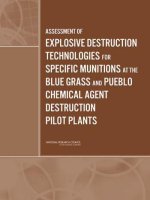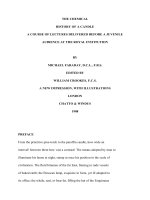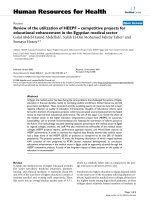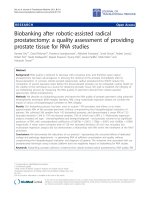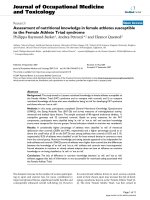ASSESSMENT OF EXPLOSIVE DESTRUCTION TECHNOLOGIES FOR SPECIFIC MUNITIONS AT THE BLUE GRASS AND PUEBLO CHEMICAL AGENT DESTRUCTION PILOT PLANTS ppt
Bạn đang xem bản rút gọn của tài liệu. Xem và tải ngay bản đầy đủ của tài liệu tại đây (1.57 MB, 135 trang )
ASSESSMENT OF
EXPLOSIVE DESTRUCTION
TECHNOLOGIES
FOR
SPECIFIC MUNITIONS AT THE
BLUE GRASS AND PUEBLO
CHEMICAL AGENT
DESTRUCTION
PILOT PLANTS
Committee to Review Assembled Chemical Weapons
Alternatives Program Detonation Technologies
Board on Army Science and Technology
Division on Engineering and Physical Sciences
THE NATIONAL ACADEMIES PRESS 500 Fifth Street, N.W. Washington, DC 20001
NOTICE: The project that is the subject of this report was approved by the Governing Board of the National
Research Council, whose members are drawn from the councils of the National Academy of Sciences, the
National Academy of Engineering, and the Institute of Medicine. The members of the committee responsible
for the report were chosen for their special competences and with regard for appropriate balance.
This study was supported by Contract No. W911NF-08-C-0034 between the National Academy of Sciences
and the U.S. Army. Any opinions, findings, conclusions, or recommendations expressed in this publication are
those of the author(s) and do not necessarily reflect the views of the organizations or agencies that provided
support for the project.
International Standard Book Number-13: 978-0-309-12683-0
International Standard Book Number-10: 0-309-12683-5
Limited copies of this report are available from Additional copies are available from
Board on Army Science and Technology The National Academies Press
National Research Council 500 Fifth Street, N.W.
500 Fifth Street, N.W., Room 940 Lockbox 285
Washington, DC 20001 Washington, DC 20055
(202) 334-3118 (800) 624-6242 or (202) 334-3313
(in the Washington metropolitan area)
Internet,
Copyright 2009 by the National Academy of Sciences. All rights reserved.
Printed in the United States of America
The National Academy of Sciences is a private, nonprofit, self-perpetuating society of distinguished scholars engaged
in scientific and engineering research, dedicated to the furtherance of science and technology and to their use for the
general welfare. Upon the authority of the charter granted to it by the Congress in 1863, the Academy has a mandate
that requires it to advise the federal government on scientific and technical matters. Dr. Ralph J. Cicerone is president
of the National Academy of Sciences.
The National Academy of Engineering was established in 1964, under the charter of the National Academy of
Sciences, as a parallel organization of outstanding engineers. It is autonomous in its administration and in the selection
of its members, sharing with the National Academy of Sciences the responsibility for advising the federal govern-
ment. The National Academy of Engineering also sponsors engineering programs aimed at meeting national needs,
encourages education and research, and recognizes the superior achievements of engineers. Dr. Charles M. Vest is
president of the National Academy of Engineering.
The Institute of Medicine was established in 1970 by the National Academy of Sciences to secure the services of
eminent members of appropriate professions in the examination of policy matters pertaining to the health of the public.
The Institute acts under the responsibility given to the National Academy of Sciences by its congressional charter to
be an adviser to the federal government and, upon its own initiative, to identify issues of medical care, research, and
education. Dr. Harvey V. Fineberg is president of the Institute of Medicine.
The National Research Council was organized by the National Academy of Sciences in 1916 to associate the broad
community of science and technology with the Academy’s purposes of furthering knowledge and advising the federal
government. Functioning in accordance with general policies determined by the Academy, the Council has become
the principal operating agency of both the National Academy of Sciences and the National Academy of Engineering
in providing services to the government, the public, and the scientific and engineering communities. The Council is
administered jointly by both Academies and the Institute of Medicine. Dr. Ralph J. Cicerone and Dr. Charles M. Vest
are chair and vice chair, respectively, of the National Research Council.
www.national-acade mies.org
v
COMMITTEE TO REVIEW ASSEMBLED CHEMICAL WEAPONS
ALTERNATIVES PROGRAM DETONATION TECHNOLOGIES
RICHARD J. AYEN, Chair, Waste Management, Inc. (retired), Jamestown, Rhode Island
DOUGLAS M. MEDVILLE, Vice Chair, MITRE (retired), Reston, Virginia
ROBIN L. AUTENRIETH, Texas A&M University, College Station
ADRIENNE T. COOPER, Temple University, Philadelphia, Pennsylvania
MARTIN K. GOLLIN, Carmagen, St. Davids, Pennsylvania
DAVID A. HOECKE, Enercon Systems, Inc., Elyria, Ohio
PAUL F. KAVANAUGH, U.S. Army Corps of Engineers (retired), Fairfax, Virginia
TODD A. KIMMELL, Argonne National Laboratory, Chicago, Illinois
GEORGE W. PARSHALL, E.I. DuPont de Nemours & Company (retired), Wilmington,
Delaware
JAMES P. PASTORICK, UXO Pro, Inc., Alexandria, Virginia
WILLIAM R. RHYNE, ABS Consulting, Inc. (retired), Kingston, Tennessee
Staff
MARGARET N. NOVACK, Study Director
HARRISON T. PANNELLA, Senior Program Officer
NIA D. JOHNSON, Senior Research Associate
JAMES C. MYSKA, Senior Research Associate
ALICE V. WILLIAMS, Senior Program Assistant
vi
BOARD ON ARMY SCIENCE AND TECHNOLOGY
MALCOLM R. O’NEILL, Chair, Lockheed Martin Corporation (retired), Vienna, Virginia
ALAN H. EPSTEIN, Vice Chair, Pratt & Whitney, East Hartford, Connecticut
RAJ AGGARWAL, Rockwell Collins, Cedar Rapids, Iowa
SETH BONDER, The Bonder Group, Ann Arbor, Michigan
JAMES CARAFANO, The Heritage Foundation, Washington, D.C.
ROBERT L. CATTOI, Rockwell International Corporation (retired), Dallas, Texas
DARRELL W. COLLIER, U.S. Army Space and Missile Defense Command (retired),
Leander, Texas
JAY C. DAVIS, Lawrence Livermore National Laboratory (retired), Livermore, California
PATRICIA K. FALCONE, Sandia National Laboratories, Livermore, California
RONALD P. FUCHS, The Boeing Company, Seattle, Washington
WILLIAM R. GRAHAM, National Security Research, Inc. (retired), San Marino, California
PETER F. GREEN, University of Michigan, Ann Arbor
CARL GUERRERI, Electronic Warfare Associates, Inc., Herndon, Virginia
M. FREDERICK HAWTHORNE, University of Missouri, Columbia
MARY JANE IRWIN, Pennsylvania State University, University Park
ELLIOT D. KIEFF, Channing Laboratory, Harvard University, Boston, Massachusetts
LARRY LEHOWICZ, Quantum Research International, Arlington, Virginia
EDWARD K. REEDY, Georgia Tech Research Institute (retired), Atlanta
DENNIS J. REIMER, DFI International (retired), Arlington, Virginia
WALTER D. SINCOSKIE, Telcordia Technologies, Inc., Morristown, New Jersey
MARK J.T. SMITH, Purdue University, West Lafayette, Indiana
MICHAEL A. STROSCIO, University of Illinois, Chicago
JUDITH L. SWAIN, University of California at San Diego, La Jolla
WILLIAM R. SWARTOUT, Institute for Creative Technologies, Marina del Rey, California
EDWIN L. THOMAS, Massachusetts Institute of Technology, Cambridge
ELLEN D. WILLIAMS, University of Maryland, College Park
Staff
BRUCE A. BRAUN, Director
CHRIS JONES, Financial Associate
DEANNA P. SPARGER, Program Administrative Coordinator
vii
The Committee to Review Assembled Chemical
Weapons Alternatives Program Detonation Technolo-
gies was appointed by the National Research Council
(NRC) in response to a request by the U.S. Army’s
Program Manager for Assembled Chemical Weapons
Alternatives (PMACWA).
Three types of detonation technologies available
from technology vendors and the Army’s explosive
destruction system (EDS), collectively known as
explosive destruction technologies (EDTs), are being
considered for use at the Blue Grass Army Depot in
Richmond, Kentucky, and the Pueblo Chemical Depot
in Pueblo, Colorado. For the destruction of the bulk of
the chemical weapons stockpiled at both sites, the cur-
rent processes that the Army has selected for the main
processing facilities center on weapon disassembly to
access agent and energetics, followed by hydrolysis of
the agent and energetics and subsequent secondary waste
treatment. EDTs are being considered as supplemental
technologies for destroying certain of the weapons at
Blue Grass and Pueblo to improved operational safety
and/or to accelerate the overall weapons destruction
schedule. The three types of vendor-supplied EDTs
under consideration are the detonation of ammunition
in a vacuum integrated chamber (DAVINCH) from
Kobe Steel, Ltd.; the transportable detonation chamber
(TDC), formerly known as the controlled detonation
chamber (CDC), from CH2M HILL; and the static
detonation chamber (SDC) from Dynasafe, formerly
known as the Dynasafe static kiln.
The committee’s focus was on updating its evalua-
tion of the EDTs presented in an NRC report from 2006,
Review of International Technologies for Destruction
of Recovered Chemical Warfare Materiel (sometimes
called the International Technologies report), thor-
oughly understanding the requirements for the EDTs at
Blue Grass and Pueblo, and then evaluating and rating
the various existing EDTs with respect to how well
they meet those requirements. The committee received
presentations by the vendors of the DAVINCH, TDC,
and Dynasafe technologies and by the U.S. Army on
the EDS. Of special interest were any improvements
or changes to the technologies and additional testing
or operational experience since the International Tech-
nologies report was prepared. The requirements at Blue
Grass and Pueblo were provided by the U.S. Army.
This report responds to the following statement of
task:
The Program Manager for Assembled Chemical Weapons
Alternatives (PMACWA) is directing the design and con-
struction of facilities for the destruction of the chemical
weapons that are stored at the Pueblo Chemical Depot
in Pueblo, Colorado, and the Blue Grass Army Depot in
Richmond, Kentucky. Both facilities will employ reverse
assembly to access agent and energetics in the weapons,
followed by hydrolysis of the agent and energetics.
However, plans currently also call for installation of a sys-
tem employing a detonation technology or the Nonstockpile
Chemical Materiel (NSCM) Project’s Explosive Destruction
System (EDS) to process leaking munitions and/or contami-
nated explosive components. Detonation technology is not
Preface
viii PREFACE
in the BGCAPP [Blue Grass Chemical Agent Destruction
Pilot Plant] design but is under consideration for process-
ing leaking munitions, mustard-filled projectiles, and non-
contaminated rocket motors. The detonation technologies
and the EDS do not employ reverse assembly of munitions
and will therefore be used to destroy atypical weapons—
weapons with either chemical or mechanical anomalies that
might result in problems when fed to the reverse assembly
process.
The detonation technologies to be considered are the
DAVINCH (detonation of ammunition in a vacuum integrated
chamber), the CDC (controlled detonation chamber) and the
Dynasafe static kiln. The DAVINCH and CDC employ an
explosive donor charge that is placed around the munition.
The munition is placed within an explosive containment
structure, and the donor charge is detonated, resulting in the
destruction of agent and energetics. The Dynasafe static kiln
employs insertion of the munition into an externally heated
kiln. The high temperature of the kiln results in deflagra-
tion, detonation, or burning of the munition’s explosive fill
and destruction of the agent. The EDS employs explosive
charges to open a munition followed by use of neutralization
chemicals to destroy the agent.
The NRC investigated the three detonation technologies
and the EDS as part of a study titled Review of Interna-
tional Technologies for Destruction of Recovered Chemical
Warfare Materiel. Most of the information presented in the
resulting report was gathered nearly two years ago. Develop-
ment and employment of these technologies has proceeded
rapidly, and an update of that review is needed. The technolo-
gies also need to be evaluated against the Pueblo and Blue
Grass requirements.
The National Research Council will establish an ad hoc
committee to
• Update the previously published evaluation of the
DAVINCH, CDC, and Dynasafe static kiln technologies
for the destruction of chemical munitions, to include
the NSCM EDS or any viable detonation technologies.
Evaluation factors will include process maturity, process
efficacy/throughput rate, process safety, public and regu-
latory acceptability, secondary waste issues, and destruc-
tion verification capability.
• Obtain detailed information on the requirements of the
specific applications at Pueblo and Blue Grass. Rank
each of the three detonation technologies and the EDS
against these requirements, and recommend a preferred
technology.
The committee was also asked to incorporate into
the report its thoughts on design changes and upgrades
that would allow the technologies to better process a
large number of mustard agent roundson the order
of 15,000 at Blue Grassin a reasonable amount of
time. This was to be done for the three vendor-supplied
technologies but not the EDS. Thoughts that were rel-
evant to the destruction of M55 rocket motors at Blue
Grass and to overpacked munitions at Pueblo were also
offered. The committee was to specifically address reli-
ability, maintainability, and capacity.
The committee held three meetings. The first was at
the National Academy of Sciences building in Wash-
ington, D.C. Presentations were received from vendors
on the Dynasafe and TDC technologies and from the
Army on the EDS. The requirements for the Blue Grass
and Pueblo sites were discussed in a teleconference
with Joseph Novad, Technical Director, Assembled
Chemical Weapons Alternatives (ACWA). The second
meeting was at the Keck Center in Washington, D.C.
A presentation on the DAVINCH technology was
received from the vendor and another on the use of
the TDC at Schofield Barracks in Hawaii was received
from the Army. The third meeting was held at the J. Erik
Jonsson Center at Woods Hole, Massachusetts.
The committee thanks the vendors and the staff of
ACWA and the Chemical Materials Agency (CMA)-
NSCM Project. The PMACWA, Kevin Flamm, and
his staff, especially Joseph Novad and Ray Malecki,
provided information on the requirements at the Blue
Grass and Pueblo sites. Information on the EDS was
received from Allan Kaplan, CMA-NSCM Project. One
member of the committee witnessed the TDC in opera-
tion at Schofield Barracks in Hawaii, which provided
valuable insight into the TDC system. The committee
thanks F. David Hoffman, System Development Group
Leader, NSCM project, for his help in arranging this
visit to Schofield Barracks. A very useful teleconference
call involving committee members, Colorado regulators,
and NRC staff was held on May 22, 2008. The com-
mittee especially wishes to thank Doug Knappe, Kevin
Mackey, and James Hindman of the Colorado Depart-
ment of Public Health and Environment (CDPHE) for
their participation. A similar and, again, very useful tele-
conference call involving Kentucky regulators was held
on July 22, 2008. The committee wishes to thank Bill
Buchanan, John Jump, Leasue Meyers, Shannon Powers,
and April Webb of the Kentucky Department of Environ-
mental Protection (KDEP) for their participation.
The committee also offers its thanks for the sup-
port and assistance of National Research Council staff
members. Support was provided by BAST director
Bruce Braun and study director Margaret Novack.
Nia Johnson, Harrison Pannella, Angela Martin, Alice
Williams, and Jim Myska capably assisted the commit-
tee in its fact-finding activities, in its meeting and trip
arrangements, and in the production of this report.
PREFACE ix
The Board on Army Science and Technology (BAST)
members listed on page vi were not asked to endorse
the committee’s conclusions or recommendations, nor
did they review the final draft of this report before its
release, although board members with appropriate
expertise may be nominated to serve as formal mem-
bers of study committees or as report reviewers. BAST
was established in 1982 by the National Academies at
the request of the Army. It brings to bear broad military,
industrial, and academic experience and scientific, engi-
neering, and management expertise on Army technical
challenges and other issues of importance to senior
Army leaders. BAST also discusses potential studies
of interest; develops and frames study tasks; ensures
proper project planning; suggests potential committee
members and reviewers for reports produced by fully
independent, ad hoc study committees; and convenes
meetings to examine strategic issues.
Richard J. Ayen, Chair
Committee to Review Assembled
Chemical Weapons Alternatives
Program Detonation Technologies
x
This report has been reviewed in draft form by indi-
viduals chosen for their diverse perspectives and techni-
cal expertise, in accordance with procedures approved
by the National Research Council’s (NRC’s) Report
Review Committee. The purpose of this independent
review is to provide candid and critical comments
that will assist the institution in making its published
report as sound as possible and to ensure that the report
meets institutional standards for objectivity, evidence,
and responsiveness to the study charge. The review
comments and draft manuscript remain confidential
to protect the integrity of the deliberative process. We
wish to thank the following individuals for their review
of this report:
Williams Bacon, Shaw Environmental &
Infrastructure,
Robert A. Beaudet, University of Southern
California,
Gene Dyer, Consultant,
Willard C. Gekler, Consultant,
Dan Luss, NAE, University of Houston,
James F. Mathis, NAE, Exxon Corporation
(retired),
John A. Merson, Sandia National Laboratories, and
William J. Walsh, Pepper Hamilton, LLP.
Although the reviewers listed above have provided
many constructive comments and suggestions, they
were not asked to endorse the conclusions or recom-
mendations, nor did they see the final draft of the report
before its release. The review of this report was overseen
by LTG Henry Hatch, U.S. Army retired. Appointed by
the National Research Council, he was responsible for
making certain that an independent examination of this
report was carried out in accordance with institutional
procedures and that all review comments were carefully
considered. Responsibility for the final content of this
report rests entirely with the authoring committee and
the institution.
Acknowledgment of Reviewers
xi
Contents
SUMMARY 1
1 INTRODUCTION 11
Purpose of This Report, 11
Requirements for Use of Explosive Destruction Technologies at ACWA Sites, 11
Requirements for the Blue Grass Site, 11
Requirement for the Pueblo Site, 12
Assembled Chemical Weapons Alternatives Program, 12
Background, 12
BGCAPP Process Description, 13
PCAPP Process Description, 14
Types of Explosive Destruction Technologies, 18
“Cold” Detonation Versus “Hot” Detonation, 19
CH2M HILL TC-60 TDC, 19
CH2M HILL D-100, 20
DAVINCH, 20
Dynasafe SDC2000, 20
Explosive Destruction System (EDS), 21
Study Scope and Report Structure, 21
References, 22
2 EVALUATION FACTORS SPECIFIC TO ACWA SITES APPLICATION 23
Selection of Evaluation Factors, 23
Description of Evaluation Factors, 23
Process Maturity, 23
Process Efficacy, 24
Process Throughput, 25
Process Safety, 25
Public and Regulatory Acceptability in a U.S. Context, 25
Secondary Waste Issues, 26
Destruction Verification Capability, 26
Process Flexibility, 27
xii CONTENTS
Assessment of Evaluation Factors Against Directives Reflected in the Statement of
Task, 28
Reference, 28
3 CURRENT STATUS OF EXPLOSIVE DESTRUCTION TECHNOLOGIES 29
Introduction, 29
Summary of Experience Since Early 2006, 29
Transportable Detonation Chamber Technology, 30
Changes to the Process Since Early 2006, 30
Additional Experience Since Early 2006, 31
Proposal for Static Firing of Noncontaminated Rocket Motors, 35
Thoughts on Design Changes and Upgrades, 36
DAVINCH Technology, 36
Changes to the Process Since Early 2006, 36
Additional Experience Since Early 2006, 38
Future Developments for DAVINCH, 41
Thoughts on Design Changes and Upgrades, 41
Dynasafe Technology, 42
Changes to the Process Since Early 2006, 42
Dynasafe SDC2000 Tests for BGCAPP, 43
Thoughts on Design Changes and Upgrades, 46
EDS Technology, 46
EDS-2, 46
Changes in the Process Since Early 2006, 49
Additional Experience Since Early 2006, 49
Future Plans, 49
Regulatory Approval and Permitting, 50
General, 50
Technology-Specific Regulatory Considerations, 51
TDC, 51
DAVINCH, 52
Dynasafe SDC, 52
EDS, 53
References, 54
4 RATING OF EXPLOSIVE DESTRUCTION TECHNOLOGIES FOR 55
PROPOSED BGCAPP AND PCAPP APPLICATIONS
Introduction, 55
Basis for Assessment, 55
Requirement BG-1: Destruction of Approximately 70,000 Noncontaminated
M55 Rocket Motors at Blue Grass, 57
Process Maturity, 58
Process Efficacy, 59
Process Throughput, 60
Process Safety, 61
Public and Regulatory Acceptability in a U.S. Context, 61
Secondary Waste Issues, 62
Destruction Verification Capability, 62
Process Flexibility, 62
Summary Assessment for Requirement BG-1, 62
CONTENTS xiii
Requirement BG-2: Destruction of Approximately 15,000 Mustard Agent H-Filled
155-mm Projectiles at Blue Grass, 64
Process Maturity, 64
Process Efficacy, 65
Process Throughput, 66
Process Safety, 66
Public and Regulatory Acceptability in a U.S. Context, 67
Secondary Waste Issues, 68
Destruction Verification Capability, 69
Process Flexibility, 69
Summary Assessment for Requirement BG-2, 70
Requirement BG-3: Destruction of Approximately 70,000 Noncontaminated M55 Rocket
Motors and Approximately 15,000 Mustard Agent H-Filled 155-mm Projectiles at
Blue Grass, 71
Process Maturity, 71
Process Efficacy, 71
Process Throughput, 71
Process Safety, 72
Public and Regulatory Acceptability in a U.S. Context, 72
Secondary Waste Issues, 73
Destruction Verification Capability, 73
Process Flexibility, 73
Summary Assessment for Requirement BG-3, 74
Requirement P-1: Destruction of All Leakers and Reject Munitions at Pueblo
Comprising Approximately 1,000 Rounds of Mustard Agent HD/HT-Filled
Munitions (Mixture of 4.2-in. Mortars and 105- and 155-mm Projectiles), 75
Process Maturity, 75
Process Efficacy, 76
Process Throughput, 76
Process Safety, 78
Public and Regulatory Acceptability in a U.S. Context, 78
Secondary Waste Issues, 79
Destruction Verification Capability, 79
Process Flexibility, 80
Summary Assessment for Requirement P-1, 80
References, 81
APPENDIXES
A Chapter 4 from the 2006 NRC Report Review of International Technologies for 85
Destruction of Recovered Chemical Warfare Materiel
B Committee Meetings and Site Visits 111
C Biographical Sketches of Committee Members 113
xv
Tables and Figures
TABLES
S-1 EDT Ratings Summary for Requirement BG-1, Destruction of Approximately 70,000
Noncontaminated M55 Rocket Motors at Blue Grass, 4
S-2 EDT Ratings Summary for Requirement BG-2, Destruction of 15,000 Mustard Agent
H-Filled 155-mm Projectiles at Blue Grass, 4
S-3 EDT Ratings Summary for Requirement BG-3, Destruction of Approximately 70,000
Noncontaminated M55 Rocket Motors and 15,000 Mustard Agent H-Filled 155-mm
Projectiles at Blue Grass, 5
S-4 EDT Ratings Summary for Requirement P-1, Destruction of All Leakers and Reject
Munitions at Pueblo Comprising Approximately 1,000 Rounds of Mustard Agent
HD/HT-Filled Munitions (Mixture of 4.2-in. Mortars and 105- and 155-mm
Projectiles), 5
1-1 Blue Grass Army Depot Chemical Weapons Inventory, 14
1-2 Description of Overpacks, 15
1-3 Pueblo Chemical Depot Weapons Inventory, 17
2-1 Process Maturity Subfactors, 24
2-2 Process Efficacy Subfactors, 24
2-3 Process Safety Subfactors, 25
2-4 Subfactors for Public and Regulatory Acceptability in a U.S. Context, 26
2-5 Subfactors for Secondary Waste Issues, 27
2-6 Subfactors for Destruction Verification Capability (for Chemical Agents), 27
3-1 Concentrations of Volatile Organic Compounds at the Inlet and Outlet of Air Filtration
Unit #2 of the TDC of CH2M HILL, 31
3-2 Emissions to the Air of Metals from the TDC of CH2M HILL, 32
3-3 Stack Emissions of Particulate Matter, Dioxin/Furan, HCl, and Semivolatile Organic
Compounds from the TDC of CH2M HILL, 32
3-4 Selected Total Metals Concentrations in Solid Waste from the TDC of CH2M HILL, 33
xvi TABLES AND FIGURES
3-5 Munition Destruction by DAVINCH at Poelkapelle, Belgium, through
July 14, 2008, 40
3-6 Recent Deployments of EDS Units, 49
4-1 Requirements Proposed for EDT Processing of Chemical Stockpile Items at Blue Grass
Army Depot and Pueblo Chemical Depot, 56
4-2 Throughput Rates of Five EDTs and Their Implications for Schedule: Requirements
BG-1, BG-2, and BG-3, 56
4-3 EDT Ratings Summary for Requirement BG-1, Destruction of Approximately 70,000
Noncontaminated M55 Rocket Motors at Blue Grass, 63
4-4 EDT Ratings Summary for Requirement BG-2, Destruction of 15,000 Mustard Agent
H-Filled 155-mm Projectiles at Blue Grass, 70
4-5 EDT Ratings Summary for Requirement BG-3, Destruction of Approximately 70,000
Noncontaminated M55 Rocket Motors and 15,000 Mustard Agent H-Filled 155-mm
Projectiles at Blue Grass, 74
4-6 EDT Ratings Summary for Requirement P-1, Destruction of all Leakers and Reject
Munitions at Pueblo Comprising Approximately 1,000 Rounds of Mustard Agent
HD/HT-Filled Munitions (Mixture of 4.2-in. Mortars and 105- and 155-mm
Projectiles), 81
FIGURES
1-1 Main operations of the BGCAPP process, 16
1-2 Main operations of the PCAPP process, 18
3-1 The DAVINCH Glid-Arc cold plasma thermal oxidizer, 38
3-2 Process flow diagram for DAVINCH, 39
3-3 Items destroyed in the DAVINCH DV50 at Poelkapelle, Belgium, 40
3-4a Dynasafe SDC2000 flow diagram showing sampling ports, 45
3-4b Dynasafe SDC2000 flow diagram showing sampling ports (continued), 45
3-5 Drawing of the EDS-2 vessel on its trailer, 47
xvii
Acronyms and Abbreviations
ACWA Assembled Chemical Weapons
Alternatives
AEL airborne exposure limit
ANS agent neutralization system
BGAD Blue Grass Army Depot
BGCAPP Blue Grass Chemical Agent Destruction
Pilot Plant
BPBGT Bechtel Parsons Blue Grass Team
CAA Clean Air Act
CaCl
2
calcium chloride
CATOX catalytic oxidation
CBARR Chemical Biological Applications and
Risk Reduction
CDC controlled detonation chamber
CMA Chemical Materials Agency
CO carbon monoxide
CWC Chemical Weapons Convention
DAVINCH detonation of ammunition in a vacuum
integrated chamber
DDESB Department of Defense Explosive Safety
Board
DE destruction efficiency
DOD Department of Defense
DRE destruction and removal efficiency
EBH energetics batch hydrolyzer
ECBC Edgewood Chemical Biological Center
EDS explosive destruction system
EDS-1 EDS Phase 1
EDS-2 EDS Phase 2
EDS-3 EDS Phase 3
EDT explosive destruction technology
EIS environmental impact statement
FSS fragment suppression system
FTO flameless thermal oxidizer
GB nerve agent (sarin)
GEKA Gesellschaft zur Entsorgung Chemischen
Kampfstoffe und Rüstungs-Altlasten
mbH
H mustard agent
H
2
hydrogen
HCl hydrochloric acid
HD distilled (sulfur) mustard agent
HEPA high-efficiency particulate air
HN nitrogen mustard
HT distilled mustard mixed with bis(2-
chloroethylthioethyl) ether
ICB immobilized cell bioreactor
LPMD linear projectile/mortar disassembly
(machine)
MPHRA multipathway health risk assessment
MPT metal parts treater
MTU munitions treatment unit
NEPA National Environmental Policy Act
xviii ACRONYMS AND ABBREVIATIONS
NEW net explosive weight
NRC National Research Council
NSCMP Non-Stockpile Chemical Materiel Project
O
2
oxygen
PBA Pine Bluff Arsenal
PBEDS Pine Bluff Explosive Destruction System
PCAPP Pueblo Chemical Agent Destruction Pilot
Plant
PCB polychlorinated biphenyl
PCD Pueblo Chemical Depot
PMACWA Program Manager for Assembled
Chemical Weapons Alternatives
PPE personnel protective equipment
RCM rocket cutting machine
RCRA Resource Conservation and Recovery Act
RCWM recovered chemical warfare materiel
RD&D research, development, and
demonstration
RDT&E research, development, testing, and
evaluation
SCWO supercritical water oxidation
SDC static detonation chamber
SFT shipping and firing tube
TDC transportable detonation chamber
TSCA Toxic Substances Control Act
TSDF treatment, storage, and disposal facility
VSL vapor screening level
VX a nerve agent
1
Summary
The Army’s ability to meet public and congressional
demands to destroy expeditiously all of the U.S declared
chemical weapons would be enhanced by the selection
and acquisition of appropriate explosive destruction
technologies (EDTs) to augment the main technologies
to be used to destroy the chemical weapons currently at
the Blue Grass Army Depot (BGAD) in Kentucky and
the Pueblo Chemical Depot (PCD) in Colorado. The
Army is considering four EDTs (detonation technolo-
gies) for the destruction of chemical weapons. Three of
them are available from private sector vendors; the fourth
is the Army-developed explosive destruction system
(EDS). Because of the high public, congressional, and
regulatory visibility of the chemical weapons destruction
program, it is critical to provide a transparent compara-
tive technical evaluation of these technologies to assist
the Army in selecting a technology or combination of
technologies to augment the main destruction operations
at BGAD and PCD.
The specific models of the three vendor-supplied
EDTs designed for use on mustard agent munitions
evaluated in this report are (1) the DV65 model of
the detonation of ammunition in a vacuum integrated
chamber (DAVINCH) technology from Kobe Steel,
Ltd.; (2) the TC-60 model of the transportable detona-
tion chamber (TDC), formerly the controlled detona-
tion chamber (CDC), from CH2M HILL; and (3) the
SDC2000 model of the static detonation chamber, for-
merly called the static kiln, from Dynasafe. These three
EDTs, along with the Army’s EDS, were previously
evaluated by the NRC for their usefulness in destroy-
ing recovered chemical warfare materiel from burial
sites, and the evaluations were reported on in 2006, in
Review of International Technologies for Destruction
of Recovered Chemical Warfare Materiel, hereinafter
referred to as the International Technologies report.
The first and the third of these three EDTS—the
DAVINCH and Dynasafe’s SDC2000—and a variant
of the second EDT (CH2M HILL’s D-100, which is
designed for the destruction of conventional weapons
only) are being considered for destruction of the nearly
70,000 M55 rocket motors at BGAD that have not been
contaminated with chemical agent. The D-100 was not
described in the International Technologies report.
The committee’s complete statement of task is
provided in the preface. Its main responsibilities are
these:
1. Update earlier evaluations of the DV-65, the
TC-60, the SDC2000, and the EDS Phase II
(EDS-2), which appeared in the International
Technologies report, as well as any other viable
detonation technologies, based on considerations
of process maturity, process efficacy, process
throughput, process safety, public and regulatory
acceptability, secondary waste issues, destruction
verification capability, and, where applicable,
flexibility.
1
1
The previous evaluations appeared in Review of International
Technologies for Destruction of Recovered Chemical Warfare
Materiel, Chapter 4, which is reprinted as Appendix A of this
report.
2 ASSESSMENT OF EXPLOSIVE DESTRUCTION TECHNOLOGIES
2. Obtain detailed information on each of the
requirements at BGAD and PCD and rate each
of the existing suitable EDTs available from the
vendors and the Army’s EDS with respect to
how well it satisfies these requirements in order
to recommend a preferred technology for each
requirement.
REQUIREMENTS FOR USE OF EXPLOSIVE
DESTRUCTION TECHNOLOGIES AT ACWA SITES
This report addresses three prospective require-
ments involving the use of EDTs to augment the pri-
mary chemical weapons destruction processes of the
Blue Grass Chemical Agent Destruction Pilot Plant
(BGCAPP), which is now under construction:
• Requirement BG-1 is the processing of approxi-
mately 70,000 M55 rocket motors at Blue Grass
that are not contaminated with agent. Current
plans call for shipment of these noncontaminated
rocket motors to an off-site location for process-
ing; destruction in an EDT is being considered as
an alternative.
• Requirement BG-2 is the processing of approxi-
mately 15,000 mustard agent H projectiles by
one or more EDTs. According to Assembled
Chemical Weapons Alternatives (ACWA) staff,
this would save approximately 8 months in the
overall BGCAPP schedule.
• Requirement BG-3 is the combination of require-
ments BG-1 and BG-2.
The report also addresses a single requirement involv-
ing the use of EDTs to augment operations at the Pueblo
Chemical Agent Destruction Pilot Plant (PCAPP):
•
Requirement P-1 is the destruction of all leakers
and reject munitions at Pueblo. About 1,000
mustard agent-filled munitions, a mixture of
4.2-in. mortars, 105-mm projectiles, and 155-mm
projectiles, would be destroyed. These munitions
will be overpacked.
THE EXPLOSIVE DESTRUCTION TECHNOLOGIES
TC-60 TDC
The CH2M HILL TDC was originally developed
in the United States and then later used for treating
abandoned chemical munitions recovered from burial
sites in Belgium. It was further refined through testing
programs in the United Kingdom and was recently
used in Hawaii to destroy recovered chemical warfare
materiel. No substantial changes have been made to
the TDC process since the International Technologies
report was published in 2006.
The TC-60 TDC has three main components: a deto-
nation chamber, an expansion chamber, and an emis-
sions control system. A munition wrapped in explosive
is mounted in the detonation chamber. The floor of the
chamber is covered with pea gravel, which absorbs
some of the blast energy. Bags containing water are sus-
pended near the projectile to help absorb blast energy
and to produce steam, which reacts with agent vapors.
Oxygen is added when destroying munitions contain-
ing mustard agent. After the explosive is detonated, the
gases are vented to an expansion chamber, then to the
emissions control system. The offgas treatment system
includes a reactive-bed ceramic filter to remove acidic
gases and to collect particulates such as soot and dust
from the pea gravel. A catalytic oxidation (CATOX)
unit oxidizes hydrogen, carbon monoxide, and organic
vapors from the gas stream before the stream is vented
through a carbon adsorption bed and released to the
atmosphere.
D-100
A nontransportable detonation chamber, termed the
D-100 and offered by CH2M HILL, has been installed
at BGAD for destruction of conventional munitions
(as opposed to the chemical stockpile stored there).
2
BGAD, in partnership with CH2M HILL, has proposed
to BGCAPP a program to test the technical feasibil-
ity of using the D-100 system to destroy the rocket
motors by static firing. The D-100 has a large detona-
tion chamber, with internal dimensions of 14 ft wide
× 16 ft high × 20 ft long. This chamber is connected
to a cylindrical expansion tank that is 10 ft in diameter
and 71 ft long. Exhaust gases pass from the expansion
tank to an air pollution control system consisting of a
cartridge-type particulate filter with pulsed jet cleaning,
followed by an exhaust fan. Approval has been obtained
from DOD’s Explosive Safety Board (DDESB) for
a site safety submission that includes the use of
49.3 lb TNT-equivalent net explosive weight (NEW)
2
The CH2M HILL D-100 technology is not suitable for destroy-
ing chemical weapons.
SUMMARY 3
total explosivesdonor plus munition. The Resource
Conservation and Recovery Act (RCRA) permitting of
this system is under way.
Before being processed, the rocket motors would be
removed from their shipping and firing tubes (SFTs) and
their fins would be banded. Banding the fins prevents
them from deploying during subsequent processing.
This allows easier handling when mounting the rocket
motors in the firing stand and, after firing, removing
the motors from the stand. The motors would then be
loaded into a static firing stand, the stand moved into
the detonation chamber, and the firing wires connected.
After the chamber door is closed, the rocket motors
would be ignited. The door would then be opened and
the chamber ventilated for 5 to 10 minutes. The firing
stand would be removed and replaced with another
firing stand freshly loaded with rocket motors. It is
expected that 4 to 6 motors can be destroyed in each
firing cycle and that the throughput rate would be up
to 18 motors per hour. BGAD has performed calcula-
tions showing that propellant in the rocket would have
a burn time of approximately 2.5 seconds and that the
temperature in the chamber would rise by 32°F for each
rocket fired.
DV65
Various DAVINCH models, corresponding to vari-
ous NEWs of the munition and its donor charge, have
been built by Kobe Steel, Ltd., under the corporate
mark KOBELCO, and used in Japan and Belgium to
destroy chemical weapons. The technology has not
been used in the United States.
The process uses a detonation chamber in which
chemical munitions are destroyed when donor charges
surrounding the munitions are detonated. Offgases are
produced that require secondary treatment. A simpli-
fied process flow diagram is shown in Figure 4-3 of
the 2006 International Technologies report (see Appen-
dix A). Since that report was issued, however, several
changes have been made and implemented as part of
the ongoing application of the DAVINCH technology
at the Belgian military facility at Poelkapelle, Belgium
(see Chapter 3). The system installed at Poelkapelle is
the DAVINCH DV50 model, a system with a slightly
lower NEW capability than the DV65 model evaluated
in this report. The most substantial change involves the
replacement of the offgas combustion chamber with
a cold plasma oxidizer. In its current configuration,
the offgases resulting from agent destruction in the
DAVINCH vessel are filtered to remove particulates
and, with oxygen from an external supply, are pumped
into the cold plasma oxidizer, which oxidizes CO to
CO
2
. Condensate water is then recovered from the
exhaust gas; the gas is passed through activated carbon
and exhausted to the atmosphere.
SDC2000
The SDC2000 static detonation chamber is manu-
factured by Dynasafe AB, a Swedish company. Details
of the design and operation of the Dynasafe process
are given in Appendix A, which is Chapter 4 of the
2006 International Technologies report. The Dynasafe
information presented in Appendix A remains gener-
ally the same.
The detonation chamber is a nearly spherical,
armored, high-alloy stainless steel vessel. The vessel
is double-walled, with the inner wall considered to be
armored (UXB International, 2007). The 7.5-cm thick-
ness of the inner wall is much greater than required by
the mechanical stress loads caused by detonation pres-
sures. Chemical munitions are placed in a cardboard
box or carrier, which is transported to the top of the
system. The boxed munitions are fed into the detona-
tion chamber through two sequential loading cham-
bers. The boxed munitions are dropped onto a heated
(550°C-600°C) shrapnel (scrap) bed at the bottom of
the detonation chamber, resulting in deflagration, deto-
nation, or burning of the munition’s explosive fill. The
chemical agent in the munitions is destroyed by the
shock wave from the detonation or by decomposition
due to the high heat in the chamber.
The offgas treatment system includes a cyclone for
removal of large particulates and a flameless thermal
oxidizer that converts carbon monoxide and hydrogen
to carbon dioxide and water. This is followed by a fast
quench system to minimize dioxin and furan formation,
acidic and basic (caustic) scrubbers, and an adsorber/
particulate filter system that uses Sorbalite, a mixture of
calcium oxides and carbonates with activated carbon.
EDS
The U.S. Army’s EDSs are trailer-mounted mobile
systems originally intended to destroy explosively con-
figured chemical munitions that are deemed unsafe to
transport. The system has been used to destroy chemi-
cal munitions with or without explosive components.
At the heart of the EDS system is an explosion contain-
4 ASSESSMENT OF EXPLOSIVE DESTRUCTION TECHNOLOGIES
ment vessel. The EDS Phase 2 (EDS-2) containment
vessel is designed to handle munitions containing up
to 4.8 lb TNT-equivalent of explosives. The EDS uses
explosive shaped charges to access the agent cavity and
to destroy any energetics in the munition. After detona-
tion of the shaped charges, reagents appropriate to the
agent to be neutralized are pumped into the vessel and
the vessel contents are mixed until the treatment goal
has been attained. After the concentration of chemical
agent falls below the treatment goal, as determined by
sampling the contents of the chamber, the liquid waste
solution is transferred out of the chamber into a waste
drum. The drummed EDS liquid waste is normally
treated further at a commercial hazardous waste treat-
ment, storage, and disposal facility (TSDF).
EVALUATION CRITERIA
A rating system of 0 to 10 was used for each of
eight evaluation factors for requirements BG-1, BG-2,
BG-3, and P-1. These ratings reflect the committee’s
assessment of how well an EDT would perform in com-
parison with other EDTs in respect to eight evaluation
factors, as described in detail in Chapter 2. The results
are shown in Tables S-1, S-2, S-3, and S-4. The overall
approach to this assessment is explained in Chapter 4.
Each committee member independently assigned a
value based on the following:
• The information made available for each candi-
date EDT;
• The discussions and deliberations of the commit-
tee members as a group; and
• A committee member’s perspective based on his
or her area of expertise.
The committee used its collective judgment in rating
technologies according to the factors and recognizes
that the procedure to some degree was a subjective one.
Furthermore, the committee did not evaluate or com-
TABLE S-1 EDT Ratings Summary for Requirement BG-1, Destruction of Approximately 70,000
Noncontaminated M55 Rocket Motors at Blue Grass
Evaluation Factor
EDT
Process
Maturity
Process
Efficacy
Process
Throughput
Process
Safety
Public and
Regulatory
Acceptability in
a U.S. Context
Secondary
Waste
Issues
Destruction
Verification
Capability
Process
Flexibility Total
D-100 8 9 10 8 10 9 N/A N/A 54
DAVINCH DV65 8 9
5 8 7 9 N/A N/A 46
SDC2000 6 9
8 9 7 7 N/A N/A 46
NOTE: The above values for each evaluation factor are the average of each committee member’s rating on a scale of 0-10. These average
values were then summed to arrive at the totals given in the last column. Small differences in the summed ratings, up to about five points,
were not considered to be significant by the committee. There was no weighting.
TABLE S-2 EDT Ratings Summary for Requirement BG-2, Destruction of 15,000 Mustard Agent H-Filled
155-mm Projectiles at Blue Grass
Evaluation Factor
EDT
Process
Maturity
Process
Efficacy
Process
Throughput
Process
Safety
Public and
Regulatory
Acceptability in
a U.S. Context
Secondary
Waste
Issues
Destruction
Verification
Capability
Process
Flexibility Total
TC-60 TDC 8 4
8 7 9 8 9 N/A 53
DAVINCH DV65 8 9
8 8 7 9 10 N/A 59
SDC2000 7 9 10 9 7 7
9 N/A 58
NOTE: The above values for each evaluation factor are the average of each committee member’s rating on a scale of 0-10. These average
values were then summed to arrive at the totals given in the last column. Small differences in the summed ratings, up to about five points,
were not considered to be significant by the committee. There was no weighting.
SUMMARY 5
TABLE S-3 EDT Ratings Summary for Requirement BG-3, Destruction of Approximately 70,000
Noncontaminated M55 Rocket Motors and 15,000 Mustard Agent H-Filled 155-mm Projectiles at Blue Grass
Evaluation Factor
EDT
Process
Maturity
Process
Efficacy
Process
Throughput
Process
Safety
Public and
Regulatory
Acceptability in
a U.S. Context
Secondary
Waste
Issues
Destruction
Verification
Capability
Process
Flexibility Total
D-100 and TC-60
TDC combination
6 7 8 7 9 8
8 9 62
DAVINCH DV65 8 9 5 8 7 9 10 9 65
SDC2000 7 9 9 9 7 7
9 9 66
NOTE: The above values for each evaluation factor are the average of each committee member’s rating on a scale of 0-10. These average
values were then summed to arrive at the totals given in the last column. Small differences in the summed ratings, up to about five points,
were not considered to be significant by the committee. There was no weighting.
TABLE S-4 EDT Ratings Summary for Requirement P-1, Destruction of All Leakers and Reject Munitions at
Pueblo Comprising Approximately 1,000 Rounds of Mustard Agent HD/HT-Filled Munitions (Mixture of 4.2-in.
Mortars and 105- and 155-mm Projectiles)
Evaluation Factor
EDT
Process
Maturity
Process
Efficacy
Process
Throughput
Process
Safety
Public and
Regulatory
Acceptability in
a U.S. Context
Secondary
Waste
Issues
Destruction
Verification
Capability
Process
Flexibility Total
TC-60 TDC
8 4 10 7 9 8 9 10 65
DAVINCH DV65
8 9 10 8 7 9 10 10 71
SDC2000
7 9 10 9 7 7 9 10 68
EDS
a
10 10 10 7 10 6 10 10
73
NOTE: The above values for each evaluation factor are the average of each committee member’s rating on a scale of 0-10. These average
values were then summed to arrive at the totals given in the last column. Small differences in the summed ratings, up to about five points,
were not considered to be significant by the committee. There was no weighting.
a
These ratings are based on the use of two EDS-2 units.
pare the technologies based on total life-cycle costs,
cost per munition destroyed, or any other economic fac-
tors due to the proprietary nature of the information that
would be needed to make such an evaluation, nor was it
asked to do so. See the section “Basis for Assessment”
at the beginning of Chapter 4 for information on how
the numerical ratings of 0 through 10 were assigned by
committee members.
Using the results of the rating procedure, the com-
mittee recommended one or more EDTs that would
best satisfy each requirement. Small differences, up
to about five points, in ratings were not considered
to be significant. The main finding and recommenda-
tion from Chapter 4 associated with each of the four
requirements—BG-1, BG-2, BG-3, and P-1—are given
at the end of the text coverage for each requirement.
A wealth of information on the characteristics and
capabilities of the technology, on recent advances in its
development, and the arguments for assigning ratings
is contained in Chapters 3 and 4, so that in addition to
noting the individual and summed numerical ratings,
a reader should review these other chapters before
engaging in discussions on the selection of an EDT for
a particular requirement.
REQUIREMENT BG-1: DESTRUCTION OF
APPROXIMATELY 70,000 NONCONTAMINATED
M55 ROCKET MOTORS AT BLUE GRASS
Noncontaminated rocket motors, unlike the associ-
ated warheads, contain no agent, so Requirement BG-1
can be considered to amount to conventional munitions
6 ASSESSMENT OF EXPLOSIVE DESTRUCTION TECHNOLOGIES
disposal. The M55 rocket motor contains 19.3 lb of
M28 double base (nitroglycerin and nitrocellulose)
cast grain propellant.
3
The U.S. Army’s EDS is not
intended
for processing M55 rockets because its explo-
sive containment capacity (4.8 lb NEW) is only about
one-fourth of the capacity needed for a rocket motor.
After discussions with the ACWA staff, it was decided
to not evaluate the TC-60 TDC for the destruction of
noncontaminated rocket motors by either a static firing
approach or a donor charge approach for Requirement
BG-1, mainly because the TC-60 TDC is not designed
for such an application but also because CH2M HILL
offers the D-100 system, which is designed to destroy
conventional weapons and which, if testing is suc-
cessful, should be usable for static firing of the non-
contaminated rocket motors. Moreover, as previously
explained, a D-100 system is already installed at
BGAD. Accordingly, the D-100 system was evaluated
for Requirement BG-1 and the TC-60 TDC was evalu-
ated for Requirement BG-2.
An analysis by BGAD concluded that between four
and six motors could be fired in each cycle with the
D-100, with the vendor claiming a firing cycle time of
20 minutes. Based on six motors per cycle, three cycles
per hour, and 10 hours per day, the daily throughput
of motors would be 180. On this basis the commit-
tee projected a campaign length ranging from about
1.2 years to about 2.5 years.
Use of the D-100 would not require attaching donor
explosives to the rocket motors. The firing of the rocket
motors would instead be initiated using the existing
igniters. If they are no longer reliable, new igniters
could be installed in the motors.
The volumes of wastes generated are small. The
scrap metal will of course be free of chemical agent.
The dust from the filter will contain lead from the lead
stearate in the propellant. It could possibly be defined
as a RCRA hazardous waste.
Two D-100 systems have been installed at the Milan
Army Ammunition Plant in Tennessee. The systems
have been permitted and were used to destroy 25,000
155-mm projectiles containing submunition grenades.
A testing program with the goal of demonstrating
that the D-100 will work as expected has been pro-
posed, but no actual testing has been done. Tests with
actual rockets would be needed before this technology
could be selected for Requirement BG-1.
3
DAVINCH
The DAVINCH DV65 is capable of destroying M55
rocket motors, although to increase throughput, a pro-
posed longer version of the DAVINCH, the DV120,
might be used. However, the DAVINCH technology has
not yet been permitted to operate in the United States
since permits required under the RCRA and other laws
cannot be applied for unless a particular application
exists.
The DAVINCH system currently being used in
Kanda Port, Japan, the DV65, has an explosion contain-
ment capacity of 65 kg TNT-equivalent. The manufac-
turer claims that it can process four M55 rocket motors
per shot with a throughput rate of nine shots (detonation
events) per 10-hour day, which amounts to a cycle time
of slightly more than 1 hour. From this information, the
committee has projected a campaign length ranging
from about 6.2 years to about 12.5 years for Require-
ment BG-1.
In limited testing, it was demonstrated that a
DAVINCH system is capable of destroying a simu-
lated rocket motor. Tests with actual rockets would be
needed before this technology could be selected for
Requirement BG-1.
SDC2000
Dynasafe has had extensive experience with the
SDC2000 model in Germany and Taiwan. The feed
system of the SDC2000 at Münster, Germany, was too
small to accommodate the long rocket motors, but the
vendor says the feed system can be enlarged if a new
system is built for BGCAPP. In addition, the NEW
limit for the SDC2000 system at Münster is limited
by permit to 2.3 kg, which is one-fourth of the NEW
of the rocket motor. It was therefore not possible to
conduct testing using a whole rocket motor. For a new
system constructed for BGCAPP, Dynasafe claims the
NEW limit can be up to 10 kg depending on the choice
of an inner chamber design specification. This is just
sufficient to withstand the unexpected detonation of a
single rocket motor with its 19.3 lb (8.8 kg) of propel-
lant. Additional testing would be needed before this
technology could be selected for Requirement BG-1.
The Dynasafe technology has not yet been given
a permit to destroy chemical weapons in the United
States. The system appears to be robust and reliable.
The throughput rate expected by the vendor for the
SDC2000 is high, 10 motors per hour. The committee


